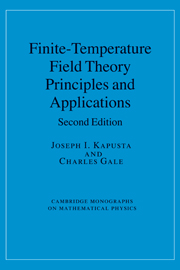Book contents
- Frontmatter
- Contents
- Preface
- 1 Review of quantum statistical mechanics
- 2 Functional integral representation of the partition function
- 3 Interactions and diagrammatic techniques
- 4 Renormalization
- 5 Quantum electrodynamics
- 6 Linear response theory
- 7 Spontaneous symmetry breaking and restoration
- 8 Quantum chromodynamics
- 9 Resummation and hard thermal loops
- 10 Lattice gauge theory
- 11 Dense nuclear matter
- 12 Hot hadronic matter
- 13 Nucleation theory
- 14 Heavy ion collisions
- 15 Weak interactions
- 16 Astrophysics and cosmology
- Conclusion
- Appendix
- Index
1 - Review of quantum statistical mechanics
Published online by Cambridge University Press: 04 November 2009
- Frontmatter
- Contents
- Preface
- 1 Review of quantum statistical mechanics
- 2 Functional integral representation of the partition function
- 3 Interactions and diagrammatic techniques
- 4 Renormalization
- 5 Quantum electrodynamics
- 6 Linear response theory
- 7 Spontaneous symmetry breaking and restoration
- 8 Quantum chromodynamics
- 9 Resummation and hard thermal loops
- 10 Lattice gauge theory
- 11 Dense nuclear matter
- 12 Hot hadronic matter
- 13 Nucleation theory
- 14 Heavy ion collisions
- 15 Weak interactions
- 16 Astrophysics and cosmology
- Conclusion
- Appendix
- Index
Summary
Thermodynamics is used to describe the bulk properties of matter in or near equilibrium. Many scientists, notably Boyle, Carnot, Clausius, Gay-Lussac, Gibbs, Joule, Kelvin, and Rumford, contributed to the development of the field over three centuries. Quantities such as mass, pressure, energy, and so on are readily defined and measured. Classical statistical mechanics attempts to understand thermodynamics by the application of classical mechanics to the microscopic particles making up the system. Great progress in this field was made by physicists like Boltzmann and Maxwell. Temperature, entropy, particle number, and chemical potential are thus understandable in terms of the microscopic nature of matter. Classical mechanics is inadequate in many circumstances however, and ultimately must be replaced by quantum mechanics. In fact, the ultraviolet catastrophe encountered by the application of classical mechanics and electromagnetism to blackbody radiation was one of the problems that led to the development of quantum theory. The development of quantum statistical mechanics was achieved by a number of twentieth century physicists, most notably Planck, Einstein, Fermi, and Bose. The purpose of this chapter is to give a mini-review of the basic concepts of quantum statistical mechanics as applied to noninteracting systems of particles. This will set the stage for the functional integral representation of the partition function, which is a cornerstone of modern relativistic quantum field theory and the quantum statistical mechanics of interacting particles and fields.
Ensembles
One normally encounters three types of ensemble in equilibrium statistical mechanics. The microcanonical ensemble is used to describe an isolated system that has a fixed energy E, a fixed particle number N, and a fixed volume V.
- Type
- Chapter
- Information
- Finite-Temperature Field TheoryPrinciples and Applications, pp. 1 - 11Publisher: Cambridge University PressPrint publication year: 2006



